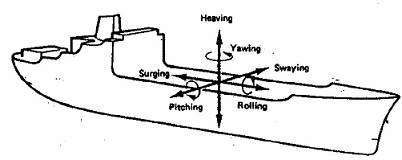Due to a variety of weather conditions, a combination of forces exerted upon a container ship and its cargo during long sea passages. Such effects may arise from pitching, rolling, heaving, surging, yawing, swaying, or combining any two or more. A large container ship while encountering these forces its Hull stress and Torsional moment will come into border if due consideration is not being given while planning container stowage.
A container vessel cargo loading thus involves many complexities, and careful consideration, if not performed during cargo planning and handling stages it may be fatal at sea. If the Master of a containership observes the stresses beyond required limits, even though applying the best Ballast and Fuel layout, the Terminal planner / Central planner must be informed and cargo stow plan appropriately modified. He should note Staggered stowage on different cargo holds, and heavy stowage around end fore and aft Bay would cause critical stress against Hull strength.
Most modern ships now employ a Hull-stress monitoring system that assists in measuring stresses in selected locations
of a hull girder. The system usually includes a database in which measurements are
recorded for subsequent reference.

Motions on a seaway
How to Avoid Hogging and sagging?
On a large containership, those responsible
for loading the ship have to take care to avoid straining the vessel’s hull. If
too much weight is placed amidships the vessel will sag. As the vessel cannot
submerge her load line mark amidships she will not be able to load her full
cargo. If excess weight is placed at the ends of the ship and not enough in the
middle the vessel may hog. If a vessel in such a condition were loaded with a
full deadweight cargo, her load line marks amidships would indicate she could
carry more cargo.
With large ships this deformity can be feet rather than inches, and
apart from the apparent tension on the hull and the puzzles already mentioned,
it may also increase the draft which is often critical for a deep-draft ship getting in
and out of port. Ships are somewhat flexible structures, and the bending may not do
much permanent harm; but if bent severely the vessel may become permanently
distorted, which is undesirable from many points of view.
To help ships’ officers and those accountable for making the essential
computations avoid this bending they must, of course, be supplied with the
essential data, gadgets, and calculators.
Any such longitudinal stresses will be exacerbated by the vessel pitching
when end on to the waves.
With smaller general-cargo ships the problem of hogging and sagging is not
so likely to be dangerous, but that of stability can well be. Ship stability can be
defined as the ability of the ship to return to the upright when slightly inclined,
and instability can result from too much top weight or, conversely, too little
bottom weight.
Related articles
How to mitigate parametric rolling?
Maintaining stability in Container Ship Operation
Larger wind area in Container Ship Operation
Fore-ward Visibility in Container Ship Operation
Container Ship navigation - Meeting with Heavy weather

Other info pages !
Ships Charterparties Related terms & guideline
Stevedores injury How to prevent injury onboard
Environmental issues How to prevent marine pollution
Cargo & Ballast Handling Safety Guideline
Reefer cargo handling Troubleshoot and countermeasures
DG cargo handling Procedures & Guidelines
Safety in engine room Standard procedures
Questions from user and feedback Read our knowledgebase
Home page

ShipsBusiness.com is merely an informational site about various aspects of ships operation,maintenance procedure,
prevention of pollution and many safety guideline. The procedures explained here are only indicative,
not exhaustive in nature and one must always be guided by practices of good seamanship.
User feedback is
important to update our database. For any comment or suggestions please Contact us
Site Use and Privacy - Read our privacy policy and site use information.
//Home //Terms and conditions of use
Copyright © 2015 www.shipsbusiness.com All rights reserved.






